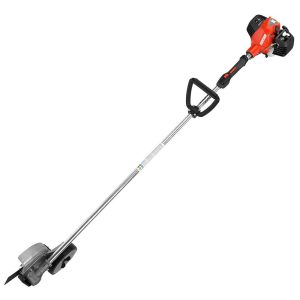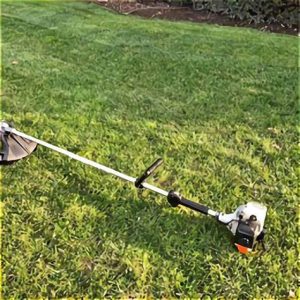9 Reasons Your Leaf Blower Starts, Stalls and Dies (SOLVED!)
No one likes to be stuck with a huge leaf removal project and a leaf blower that keeps dying. There are so many different things that can negatively affect a leaf blower.
One of the biggest culprits is the age and type of fuel you use. I’ll go over the negative effects of fuel and give you some other reasons your leaf blower may stop running.
A leaf blower starts and then dies from old fuel, a plugged air filter, a clogged fuel tank vent, a plugged fuel filter, clogged fuel lines, or a dirty carburetor. It can also stop running when the spark arrestor is clogged, the cooling system is plugged or the choke isn’t set in the correct position.
Always take safety precautions before working on your leaf blower. This includes removing the spark plug wire, waiting for the engine to cool, and waiting for all parts to stop moving.

This post may include affiliate links. Purchases made through these links may provide a commission for us, at no extra cost to you. As an Amazon Associate, we earn from qualifying purchases.
Follow all safety instructions provided in your equipment operator’s manual prior to diagnosing, repairing, or operating.Consult a professional if you don’t have the skills, or knowledge or are not in the condition to perform the repair safely.
Table of Contents
Reasons Your Leaf Blower Starts Then Dies
Incorrect Choke Setting Causes a Leaf Blower to Start Then Die
Double-check the choke lever on your blower to make sure it isn’t in the on position after the blower gets warm. If it is, this can cause the blower to shut off after it starts.
The choke is used to restrict air to the engine to allow more gas when starting a cold engine. Once the engine gets warm, the choke needs to be moved to the off position to all airflow so the engine continues to run.
Plugged Air Filter Causes a Leaf Blower to Start Then Die
One of the reasons a leaf blower starts and dies is the air filter. This filter is installed in the blower to keep out dirt so only clean air gets to the engine.
Because of the dirty dusty conditions a leaf blower presents, the filter keeps dirt and debris from entering the carburetor throat and wearing on the engine. A filter can become so plugged that sufficient air cannot pass through it and the blower will quit running.
I recommend replacing the air filter annually if you use your blower like the average homeowner and checking it several times throughout the season.
If you are using the filter in very dirty conditions, for commercial purposes, or more than the average homeowner, check and replace the filter more often.
Check the air filter to make sure it is in good condition and not restricting airflow. First, close the choke so dirt doesn’t enter the carburetor throat, and then follow the instructions to clean your type of air filter.
Clean a leaf blower FELT or PAPER air filter:
- Remove the air filter cover and remove the air filter.
- Wipe any dirt or debris remaining in the air filter cover or housing.
- Brush the dirt off the air filter.
- Install the clean filter. Replace a very dirty filter with a new one.
- Reattach the air filter cover.
Clean a foam pre-cleaner filter (if your blower uses one):
The pre-cleaner can be cleaned with water and a mild dish detergent solution. Rinse until the water runs clear and squeeze to remove all excess water. Allow drying before installing. DO NOT ADD OIL to the pre-filter.
REPLACE THE AIR FILTER if it is structurally damaged or extremely dirty. Because there are so many different types of filters used which varies from model to model, refer to your operator’s manual for steps to clean different types of air filters for your leaf blower.
Old or Bad Fuel Causes a Leaf Blower to Start Then Die
Using fresh fuel is best for your leaf blower. This is because old gas can have negative effects on the small engine.
Gasoline can begin breaking down as soon as 30 days after purchase. This can make fuel less effective. Most types of gasoline include ethanol. This is a plant-based alternative fuel to make gas more environmentally friendly.
Ethanol attracts moisture to the fuel system. The ethanol and water mixture leaves behind varnish and can gum up the fuel system. This can damage fuel components and restrict fuel flow.
Because of the effects of ethanol, it is important to never run gas with high levels of ethanol through your leaf blower. Leaf blowers require gasoline with a minimum octane rating of 89 and a maximum ethanol content of 10 percent.
- 2-cycle leaf blowers require a fuel mixture of gasoline and 2-cycle engine oil. Gas is typically mixed with oil at a ratio of 50:1, 40:1, or 32:1. Read more about mixing gas in “This is the Type of Gas and Oil Leaf Blowers Use”.
- 4-cycle leaf blowers require straight gasoline. Do not mix gas with oil. 4-cycle engines have a fill port for gasoline and a separate fill port for engine oil.
Use a fuel stabilizer in your leaf blower
Because gas can break down so quickly, add a fuel stabilizer like Sea Foam Motor Treatment to fresh fuel to make it last a little longer without breaking down. A fuel stabilizer can help minimize fuel issues from running old gas.
Keep in mind some 2-cycle oils include a fuel stabilizer. Even though the bottle of oil states it includes a stabilizer, read the fine print to see how long the additive will keep the fuel stable. If it doesn’t state a timeframe, don’t assume it will work longer than 30 days.
Plugged Fuel Filter Causes a Leaf Blower to Start Then Die
Old dirty fuel can clog the fuel filter keeping a good flow of fuel from running through the leaf blower. You will find the fuel filter inside the fuel tank. It’s attached to the end of the fuel line.
When it becomes plugged, the blower won’t get sufficient fuel and will die. To avoid this happening to you, replace your fuel filter annually and run clean fuel through your blower.
If you are using your blower for commercial purposes, you should change the fuel filter more frequently.
Replace a leaf blower fuel filter:
- Wipe around the fuel cap to remove dirt and debris so they don’t fall into the tank.
- Remove the cap.
- Pull the fuel filter out of the fuel tank. A clean bent wire works well to retrieve the filter.
- Once the filter is out of the tank, remove it from the fuel line. Be careful not not lose the retaining ring. Keep the ring on the fuel line.
- Attach the new fuel filter by inserting the male end into the fuel line and securing the line to the filter using the retaining ring.
- Place the fuel filter back inside the fuel tank.
- Install the fuel cap.
Clogged Fuel Lines Causes a Leaf Blower to Start Then Die
Old fuel can leave behind gummy deposits that can restrict fuel flow through the fuel lines. When this happens, remove the fuel line and install a new fuel line of the same diameter and width.
When inspecting your fuel lines you find them dry and cracked, you should replace the line before it begins leaking or drawing air into the line from a puncture.
Plugged Fuel Tank Vent Causes a Leaf Blower to Start Then Die
The fuel tank must be able to vent. Without a vent to allow air to pass through it and into the tank, the tank will form a vacuum. It won’t allow fuel to leave the fuel tank.
If you are not getting sufficient fuel to the carburetor and don’t have a clog in the fuel line or filter, you need to check the vent.
To confirm the fuel tank vent is clogged, place your leaf blower on a level surface, loosen or remove the cap to allow air into the tank, and start the blower.
If the blower starts and runs fine, tighten the fuel cap onto the fuel tank and allow the leaf blower to continue to run. You will confirm a problem with the fuel tank vent if the blower starts to run sluggish and die with the cap on.
Replace a clogged fuel tank vent. The fuel tank vent may be located in the fuel cap on some leaf blowers. It may also be a separate component on other blowers.
If you don’t see a vent in the fuel cap, check to see if there is a separate vent attached to a fuel line coming out of the fuel tank.
Dirty Carburetor Causes a Leaf Blower to Start Then Die
The carburetor mixes the correct proportion of air and fuel required for your leaf blower to start and continue to run. The passageways can become clogged and the small components can fail to function correctly which can be the reason the blower stops running.
Old fuel usually plays a part in the carburetor no longer working. You may be able to clean or rebuild the carburetor to get it working again. You will have to replace the carburetor if this doesn’t work.
Plugged Cooling System Causes a Leaf Blower to Start Then Die
The engine must be kept cool so it doesn’t overheat. To help cool the engine, you must remove grass, dirt, and debris that block the air intake and cooling fins.
To do this, first, remove the spark plug and wait for the engine to cool. Remove the engine cover and remove debris from the cover and around the outside of the cylinder.
Clean the cylinder fins and reinstall the engine cover. Continue cleaning the blower to make sure cool air can circulate around the engine.
On a backpack leaf blower, remove any debris from the grill between the backpack and blower housing. On a handheld blower, remove the debris from the intake and discharge grill.
Plugged Spark Arrestor Causes a Leaf Blower to Start Then Die
There is a small metal screen that keeps hot exhaust material from shooting out of the leaf blower and causing injury or starting a fire. This small screen will become plugged with a buildup of carbon that will affect how the engine runs.
Disconnect the spark plug wire. On most leaf blower models, you will remove the engine cover and the engine exhaust cover to access the spark arrestor screen.
Carefully remove the spark arrestor screen and clean it with a metal brush. If the screen isn’t able to be sufficiently cleaned or you find it is damaged or has a hole in it, replace it with a new spark arrestor screen.
To minimize carbon building up on the spark arrestor quickly, make sure you periodically run your blower at full throttle. Letting your blower idle or run at low speeds for a long time will contribute to a buildup of carbon.
Consult your operator’s manual for instructions on locating and cleaning the spark arrestor screen on your leaf blower.







